
De Kleine Komedie is today the oldest theatre in Amsterdam, dating from 1788. Situated on the Amstel near the Halvemaansteeg, the building offers a stage for both upcoming and established Dutch talents. The theatre has 503 seats.

De Kleine Komedie is today the oldest theatre in Amsterdam, dating from 1788. Situated on the Amstel near the Halvemaansteeg, the building offers a stage for both upcoming and established Dutch talents. The theatre has 503 seats.
The first theatre built in Amsterdam was the Schouwburg of Van Campen on Keizersgracht 384 in 1637, which burned down in 1772. That theatre company then moved to the Leidseplein, where it built a theatre in 1774, the first Stadsschouwburg. That building burned down in 1892 (the present building was built in 1894), making De Kleine Komedie the oldest surviving theatre in Amsterdam.
In 1784 Henry Hope of Hope & Co. purchased ground on the Amstel near the east side of the Halvemaansteeg in Amsterdam, together with his fellow banker friends Balthazar Elias Abbema, Pieter de Smeth, Henry Fizeaux, Jean Alexander Botereau, and Pieter Muilman. [1] They commissioned the building to the architect Abraham van der Hart who completed it in 1788. [2] The commissioners were all very influential men of Amsterdam who had far reaching connections. Henry Fizeaux was a banker who had close ties with John Adams and Benjamin Franklin. He tried to raise funds for the American cause and shared revolutionary sympathies, though merchant tradition was to deny political preferences. The 'Patriotic' or 'Anti-Orange' sympathies of the directors Henry Fizeaux and Jean Alexander Botereau resulted in their stepping down in 1787 when the House of Orange was re-established. Orangist Henry Hope took over the running of the establishment until he fled the country before Napoleon's army in 1794.
It was called the Théâtre Français sur l'Erwtemarkt in 1794, the year performances began. In those days, the performances were often in French and modelled on a Parisian theater form that was very popular. Napoleon himself supported the Théâtre Français, and French opera's and plays were shown in the theatre well into the 19th century.
When the interest in French plays decreased, the building was sold to the 'Neues Deutsches Theater' that performed German plays. In 1856 the building came into the hands of the Free Church of Scotland and was rechristened 'Scottish Missionary Church'. The driving force behind the Dutch branch of this church was the Rev. August Ferdinand Carl Schwartz (1817–1870), the father of the novelist Maarten Maartens.
When the Vrije Universiteit (Free University) of Amsterdam started in 1880, it hired some rooms in the Scottish Missionary Church and used them as lecture rooms. Here the founder Abraham Kuyper and his four co-professors gave their lectures. In 1883 the Scottish Missionary Church became too small for the quickly growing number of students and the university bought another building.
In the first half of Twentieth Century the building was called Salvatori and was used as a meeting centre. The most various groups met here, from orthodox Protestants to leftist freethinkers. During the Second World War the building was no more than a bicycle shed.
In 1947 the building was reopened as a theatre, now under its present name 'De Kleine Komedie'. Since then its program is primarily in Dutch. In the Fifties and Sixties many famous people in the Dutch entertainment world, like Toon Hermans, Wim Kan and Fons Jansen, made appearances in this theatre. In 1973 the building was closed by the Amsterdam fire brigade due to fire hazard. After a renovation financed by private sources, it was reopened in 1978.
In 1988 the continued existence of De Kleine Komedie was put in danger again, when the municipality of Amsterdam wanted to withdraw its subsidy. A campaign launched by the cabaret performer Youp van 't Hek secured the theatre's subsidy.
Because of its cosy atmosphere De Kleine Komedie is often used for try-out performances by upcoming talents as well as long-established cabaret performers. Many DVD and TV productions are recorded here.

Amsterdam is the capital and most populated city of the Netherlands. It has a population of 921,402 within the city proper, 1,457,018 in the urban area and 2,480,394 in the metropolitan area. Located in the Dutch province of North Holland, Amsterdam is colloquially referred to as the "Venice of the North", for its large number of canals, now a UNESCO World Heritage Site.

The Royal Concertgebouw is a concert hall in Amsterdam, Netherlands. The Dutch term "concertgebouw" translates into English as "concert building". Its superb acoustics place it among the finest concert halls in the world, along with Boston's Symphony Hall and the Musikverein in Vienna.
The year 1788 in architecture involved some significant events.

The English Reformed Church is one of the oldest buildings in Amsterdam, situated in the centre of the city. It is home to an English-speaking congregation which is affiliated to the Church of Scotland and to the Protestant Church in the Netherlands.

The Vondelpark is a public urban park of 47 hectares in Amsterdam, Netherlands. It is part of the borough of Amsterdam-Zuid and situated west from the Leidseplein and the Museumplein. The park was opened in 1865 and originally named Nieuwe Park, but later renamed Vondelpark, after the 17th-century playwright and poet Joost van den Vondel. The park has around 10 million visitors annually. Within the park is an open-air theatre, a playground and several food service facilities.

Villa Welgelegen is a historical building in Haarlem, the Netherlands, which currently houses the offices of the provincial executives of North Holland. Located at the north end of a public park in the city, it is an example of neoclassical architecture, designed by Abraham van der Hart and unusual for its style in the Netherlands.
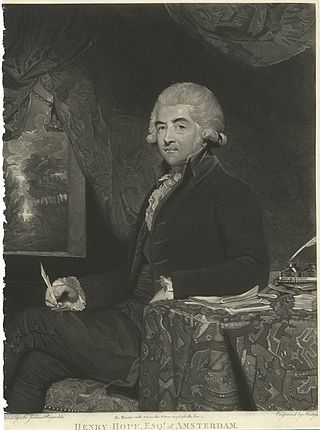
Henry Hope (1735–1811) was an Amsterdam merchant banker born in Braintree, Province of Massachusetts Bay. He emigrated to the Netherlands to join the family business Hope & Co. at a young age. From 1779, Henry became the manager of Hope & Co. and he participated in the firm for about a third from 1782. He is considered to be as great a genius as his uncle Thomas Hope. In 1786 Adam Smith dedicated the fourth edition of his book The Wealth of Nations to Henry Hope in hopes of increasing his readership:

Hope & Co. was a Dutch bank that existed for two and a half centuries. The bank was located in Amsterdam until 1795; originally it concentrated on Great Britain. From 1750 it played a major part in the finances of the Dutch East India Company (VOC) through Thomas Hope and his brother Adrian. During the Seven Years' War (1756–1763) the Hope brothers profited from the Netherlands' neutral position and became very wealthy. The Hopes became heavily involved in the Dutch Caribbean, and Danish West Indies. They specialised in plantation loans, in which the entire produce of the plantation was remitted to the lender, who would supervise its sale in order to secure repayment. In this way, the Hopes helped the plantation economy to become integrated into a global network of financiers and consumers. The Hope family were among the richest in Europe at the time. The family business focused on financing commercial transactions and especially on issuing money loans to monarchs and governments in Denmark, Sweden, Poland, Russia, Portugal, Spain, France and America. The bank was famous for having Catherine the Great as their client and Adrian supplied her several times with diamonds.

The Noorderkerk is a 17th-century Protestant church in Amsterdam, The Netherlands. The Noorderkerk is located along Prinsengracht canal, on Noordermarkt square. The church is used for Dutch Reformed Church services and is also used regularly for classical music concerts.
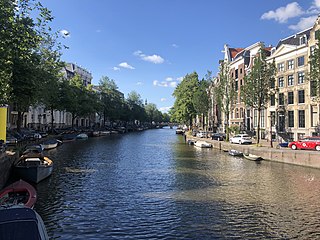
The Keizersgracht is a canal in Amsterdam, the Netherlands. It is the second of the three main Amsterdam canals that together form the Grachtengordel, or canal belt, and lies between the inner Herengracht and outer Prinsengracht.

Wende Snijders, known mononymously as Wende is a Dutch singer.
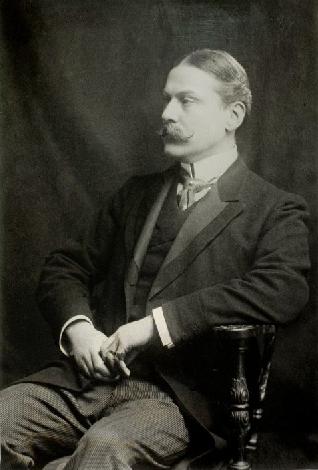
Maarten Maartens, pen name of Jozua Marius Willem van der Poorten Schwartz, was a Dutch writer, who wrote in English. He was quite well known at the end of the nineteenth and the beginning of the twentieth century, in both the UK and the US, but he was soon forgotten after his death.
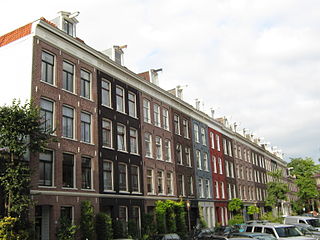
De Pijp is a neighbourhood of Amsterdam, Netherlands. It is located directly south of Amsterdam's city centre and it is part of the borough Amsterdam-Zuid, in a part of the city known as the Old South. It is served by De Pijp metro station. Most streets in De Pijp are named after Dutch painters, like Jan Steen, Frans Hals, Ruysdael and Vincent van Gogh. The three districts composing the area are Oude Pijp, Nieuwe Pijp and Diamantbuurt.

Elswout is a historical buitenplaats dating from the 19th century in a park by the same name in Overveen, Netherlands.

The Royal Theater Carré is a Neo-Renaissance theatre in Amsterdam, located near the river Amstel. When the theatre was founded in 1887, it was originally meant as a permanent circus building. Currently, it is mainly used for musicals, cabaret performances and pop concerts. Carré is located next to the Amstel, close to Waterlooplein. Its address is Amstel 115 and has approximately 1,700 seats.
The following is a timeline of the history of the municipality of Amsterdam, Netherlands.

Willem Hendrickszoon de Keyser was a Dutch Golden Age architect and sculptor primarily active in Amsterdam and London.

Maria Hoofman (1776–1845), was a 19th-century art collector from the Netherlands.
The following is a timeline of the history of the municipality of Haarlem, Netherlands.
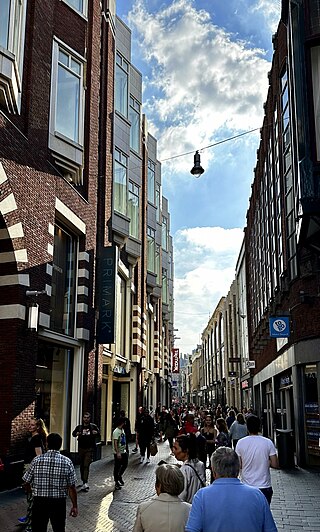
The Nieuwendijk is a major shopping street in central Amsterdam. There are some 200 shops along the street. The street, which dates to the early medieval history of Amsterdam, counts 98 buildings with rijksmonument status.